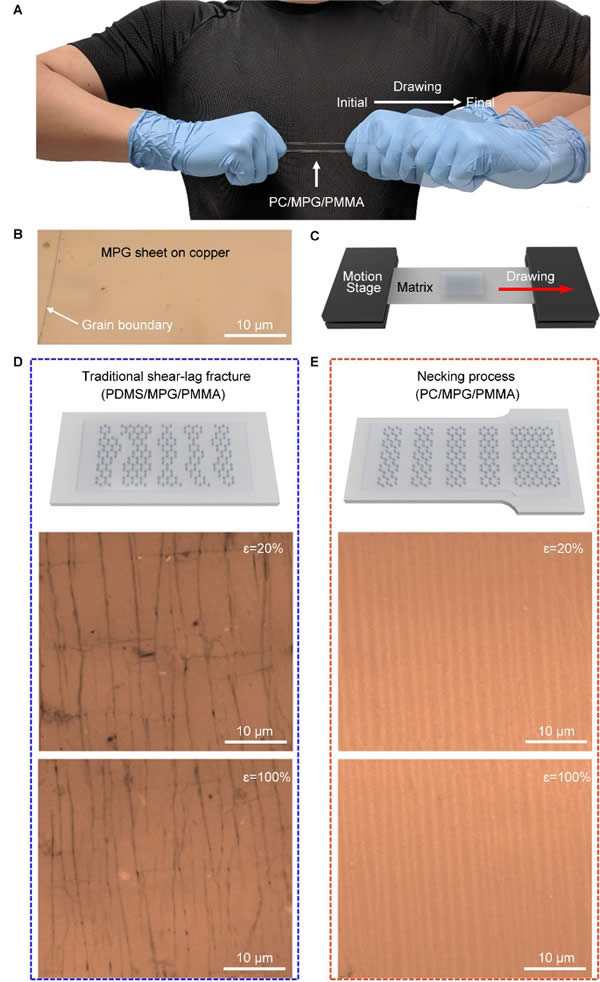Recently, Chen Ming, associate researcher of the Photonic Information and Energy Materials Research Center of the Shenzhen Institute of Advanced Technology, Chinese Academy of Sciences, and Wei Lei, a professor of the Department of Electrical and Electronic Engineering at Nanyang Technological University in Singapore, developed a controlled fracture technology for single-layer polycrystalline graphene . Related results are published online in Matter (DOI: 10.1016 / j.matt.2019.11.004) in the paper Controlled fragmentation of single-atom-thick polycrystalline graphene ("Controlled fragmentation of single-atom-thick polycrystalline graphene"), Chen Ming As the first author, Wang Zhixun is the co-first author, and Wei Lei is the corresponding author.
Under the applied stress conditions, for example, the nano-film material is stretched by the traditional stretching method (using PDMS and other flexible materials as the substrate), the cracks formed on the stretched nano-film material often have simultaneous, random and uncontrollable Features, the patterns obtained from this are always disordered. This is because the strain of the base material is globally distributed. This globally distributed strain is transmitted to the nano-film through the adhesion and friction between the substrate and the nano-film, so that multiple defects in the film simultaneously produce stress concentration, so that the local stress at these defects reaches the fracture of the material Strength, form cracks and propagate, these expanded cracks may further interact with other defects, change the propagation path of the crack, and eventually form a disordered fracture pattern on the nano-film.
If in the process of stretching the nano-film, the strain of the substrate is locally distributed and controllable, then the strain transmitted to the nano-film is also locally distributed and controllable, which makes the nano-film controllable fracture or patterned nano The film becomes possible.
Based on the above ideas, the team thought of the necking process in the field of thermoplastic polymer processing. The necking process refers to the local necking phenomenon of the thermoplastic polymer under the effect of applied tensile stress. This local necking will move under the continuous tensile stress and is accompanied by strong local strain, which makes the necking The width and thickness of the passing part are reduced, the length is extended, and finally extended to the entire layer of polymer. Inspired by the local strain that propagates dynamically during this process, the team designed a sandwich structure of single-layer polycrystalline graphene and polymer composite-polycarbonate / polycrystalline graphene / polymethyl methacrylate After a simple necking process, a very interesting phenomenon was finally observed: the graphene remained intact in the unnecked part; after the necking, the graphene broke into an orderly and uniform width Nano-sized strips. Throughout the process, the fracture of graphene occurs in an orderly manner with the spread of necking.
In addition to being a simple, easy-to-use, low-cost, and time-consuming nano-film patterning technology, this technology also has the following advantages: The resulting graphene nanoribbons have an active boundary that is increased by tens of thousands of times. Using this excellent property, the team proved that compared with the polycrystalline graphene film without ordered fracture treatment, the obtained graphene nanoribbons can be more easily doped with high concentration nitrogen, and the prepared pH chemical sensor has higher sensitivity . This controllable local strain technique can provide macroscopic experimental data for quantitatively studying the behavior and influence of various defects in the fracture of polycrystalline graphene, which can further clarify the mechanical behavior of defects and provide for the growth and large-scale of graphene The application provides guidance.
The research work was supported by the National Natural Science Foundation of China.

Controlled fracture of single-layer polycrystalline graphene using local strain cutting technology
GUANGDONG LAVIUS LIGHTING CO., LTD. , https://www.laviuslighting.com